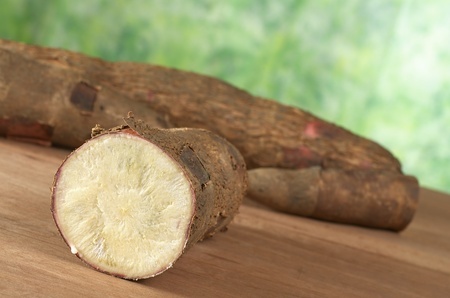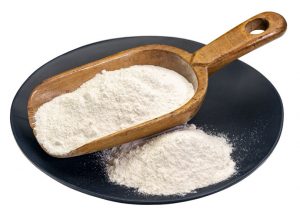
Cassava tubers (Manihot esculenta, Crantz) provide an important food source. They are especially rich in carbohydrate and thus calories in Africa, parts of the Far East, West Indies and South America especially Brazil.
Cassava is now exported to many Western countries. It is reckoned to feed up to 500 million people in tropical areas where it is nearly 50% of the total energy source of food (Sansome-Smith, 2013). World production of cassava in 2012 was about 220 million Tonnes.
Some cultures will refer to it as yuca or manioc and it is possible to buy yuca flour now in many grocers throughout the world.

Nutritional Composition Of The Tubers
The root contains between 62 and 80%w/w water and 35%w/w carbohydrates. The protein content is about 0.7 to 2.6%w/w and of poor quality, 0.3% fat, 1 or 2% fibre and 1% w/w minerals.
The amino-acid content is very weak, especially on the sulphur containing types such as methionine and cysteine (Johnson and Raymond, 1965). The leaves actually have a higher biological value in terms of their protein content.
Some nutritionists have a lower regard for the tuber than they should because compared to potato and yams, the nutritional value is not as high as some would like.
Having stated all that it is a vegetable which has retained value because of its ease of growth in many sub-tropical and tropical climates where other vegetables do not easily grow.
Cassava Is Rich In Vitamin C
Cassava tubers are a good source of vitamin C which is important for general health especially in maintaining immunity and for natural collagen production.
A cup of cooked cassava still retains 29mg of this sunshine vitamin and that is still 39 per cent of your recommended daily intake. Taken with other vegetables, there should be enough to meet your total daily requirement.
Cassava Contains Lost Of Antioxidants
As well as vitamin C which is an antioxidant in its own right, there are a number of anti-inflammatory phenolic compounds which are worth ingesting. Cassava roots offer a diverse selection which are claimed to help with both short- and long-term health issues where inflammation management is concerned.
Fibre And Complex Carbohydrates
Cassava is well known as a source of starch but this means it is a good source of basic carbohydrate related energy. There is some resistant starch too which means it provides some dietary fibre that often gets overlooked.
About 4g of dietary fibre is found in a cup of cassava. Dietary fibre is well established as an important probiotic which kepps the gut flora and fauna ‘happy’, a regulator for sugar intake which impacts on diabetes management and on regulating blood cholesterol levels.
Toxicity Issues!
One peculiarity – the tuber contains cyanogenic glycosides. The cyanogenic acid content ranges from 10 to over 500 mg HCN (hydrogen cyanide) equivalents per kg dry weight (Siritunga and Sayre, 2004), or approx. 25 mg/kg flour and so the plant must be washed and ground under running water before consumption. A lethal dose for humans of hydrogen cyanide is 40 to 60 mg (Coursey, 1973) and there have been cases of poisoning but the traditional methods of preparation are highly effective at preventing such occurrences. Cassava yields a fine starch (CS), which is produced at relatively low cost compared to other polysaccharides because of the abundance of the feedstock.
Cooking With Cassava
Cassava is processed into various food ingredients. It is often used in place of potato. The starch is used for making various types of bread.

- Fufu
(i) The sweeter cultivars are washed, peeled, boiled and then pounded or mashed to make a paste or dough which is then consumed with soups and broths.
(ii) The fresh roots are also washed with the fine bark removed and peeled off. Sieving in water removes remaining dirt. these roots are boiled in a number of changes of water to remove dissolved cyanides. The roots are always pounded or mashed before eating.
- Gari
A fine and gritty flour is prepared by peeling off the bark of the tuber, washing and then grating the root. The roots are usually placed into bags before fermenting and then macerating to a fine consistency. Sieving and roasting over an open fire in shallow pots or pans improves the use of the flour. palm oil also helps improve consistency. This is known as gari and is eaten as a cereal with milk or prepared into fufu it is prepared with hot water.
Yuca Or Cassava Starch
Cassava starch is a valuable material for creating edible coatings where it effectively reduces the respiration rate and water loss, especially when applied to minimally processed fruits (Chiumarelli et al., 2010; Garcia et al., 2012).

Cassava Fibre
Cassava pulp is a valuable by-product from starch manufacture and contains 50 to 70 %w/w starch on a dry weight basis with 20 to 30% being fibre. That high level could be put to further use in product development as it is normally used as fertilizer or animal feed (Pandey et al., 2000; Sriroth et al., 2000). More could be made of this fibre for food use !
References
Chiumarelli, M., Hubinger, M.D. (2012) Stability, solubility, mechanical and barrier properties of cassava starch – carnauba wax edible coatings to preserve fresh-cut apples. Food Hydrocolloid 28(1) pp. 59–67.
Chiumarelli, M., Pereira, L.M., Ferrari, C.C., Sarantopoulos, C.I.G.L., Hubinger, M.D. (2010) Cassava starch coating and citric acid to preserve quality parameters of fresh-cut “tommy atkins” mango. J Food Sci 75(5):E297–304.
Coursey, D.G. (1973) -Cassavas food: toxicity and technology. In: Chronic Cassava Toxicity. Ed. Nestel, B. and MacIntyre, R. p. 27. Proceedings of an interdisciplinary workshop, London, January 29-30. 1973. International Development Research Center Monogram IDRC-OlOe.
Garcia, L.C., Pereira, L.M., Sarantopoulos, C.I.G.L., Hubinger, M.D. (2012) Effect of antimicrobial starch edible coating on shelf-life of fresh strawberries. Packag. Technol. Sci. 25(7) pp. 413–25.
Johnson, R.M. and Raymond, W.D. (1965) The chemical composition of some tropical food plants. 4. Manioc. Trap. Sci. 7 pp.109.
Siritunga, D., Sayre, R. (2004) Engineering cyanogen synthesis and turnover in cassava (Manihot esculenta). Plant Mol. Biol. 56 pp. 661–9
Sriroth, K., Chollakup, R., Chotineeranat, S., Piyachomkwan, K. Oates, C.G. (2000). Processing of cassava waste for improve biomass utilization. Bioresource Technol., 71 pp. 63-69
Pandey, A., Soccol, C.R., Nigam, P., Soccol, V.T., Vanderberghe, L.P.S. & Mohan, R. (2000). Biotechnological potential of agroindustrial residue II: cassava bagasse. Bioresource Technol., 74, pp. 81-87
I read with some interest this article about cassava simply because I use it for African and Jamaican style cooking. I read that it has a high fiber content which makes it ideal for me and of course it is gluten free. I reckon you should make more emphasis of this quality. needs to be cooked well though !